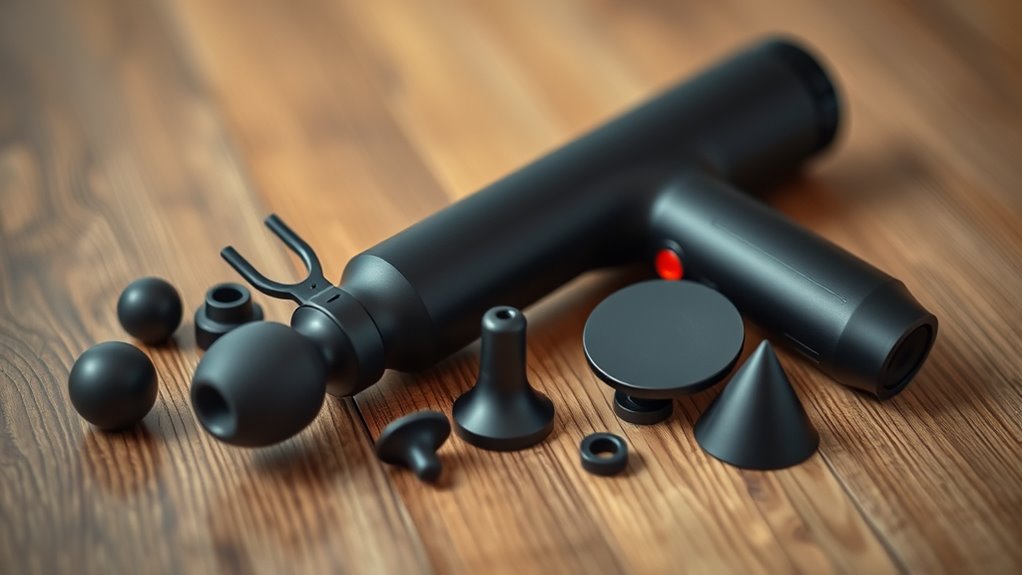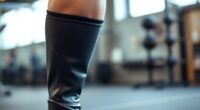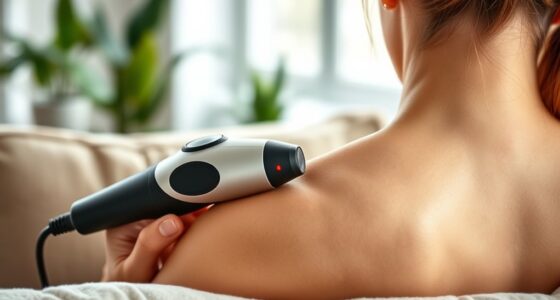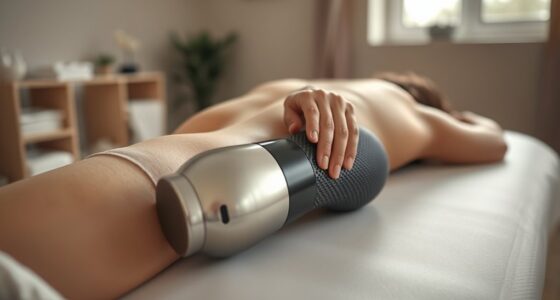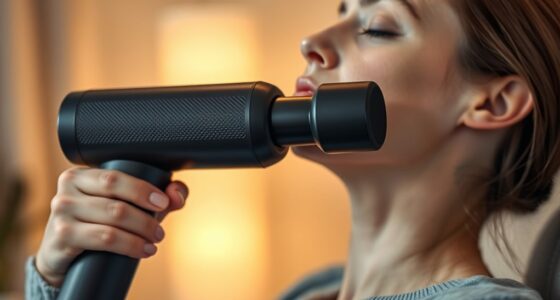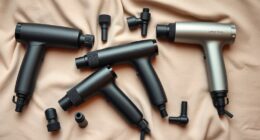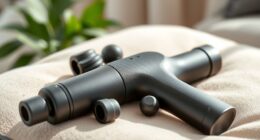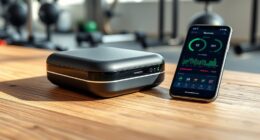To get the best results, use different massage gun attachments for specific needs. The ball attachment covers large muscles like your back and thighs, while the bullet and cone target pinpoint knots and trigger points. The fork and wedge help target tricky areas around your neck and spine, and the thumb mimics a human thumb for deep relief. For a full guide on each attachment’s use, keep exploring—they’re key to effective muscle recovery.
Key Takeaways
- Different attachments target specific muscle groups, such as balls for large muscles and cones for trigger points.
- Use larger attachments like the ball or flat for broad areas and smaller ones like the cone or bullet for pinpoint relief.
- Choose attachments based on the treatment goal: deep tissue, fascia release, or fascia relaxation.
- Proper technique involves steady pressure, slow movements, and selecting the right attachment for comfort and effectiveness.
- Compatibility and ergonomic design enhance ease of use; switching attachments allows comprehensive muscle recovery.
Ball Attachment
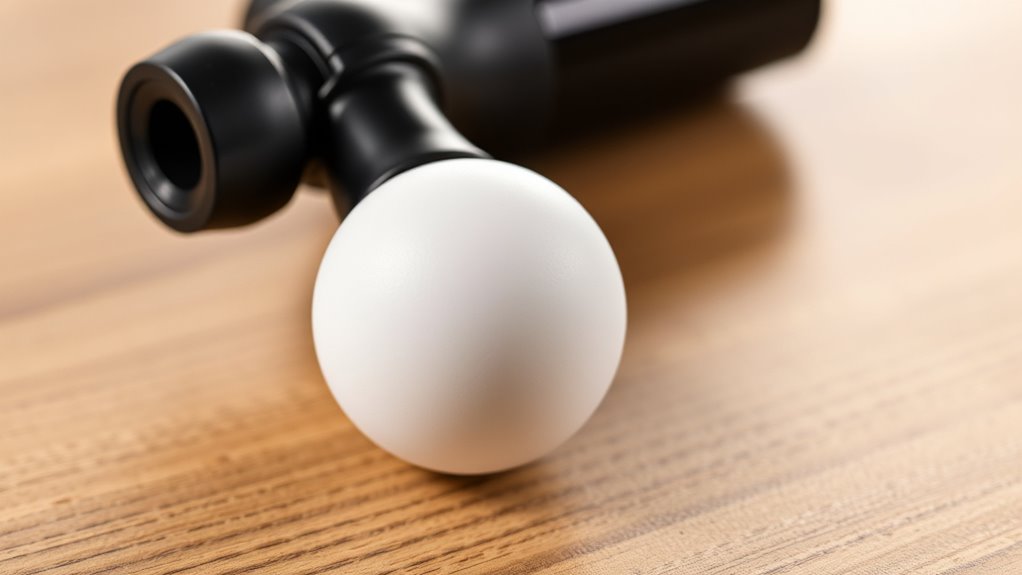
The ball attachment is a popular choice for targeting large muscle groups and providing a general, all-around massage. It’s ideal for massage therapy because it covers broad areas, helping to loosen tight muscles and improve circulation. When you use the ball attachment, you can effectively target areas like your thighs, back, and glutes, promoting muscle recovery after intense workouts. Its soft, rounded surface minimizes discomfort while delivering deep tissue stimulation. This makes it perfect for reducing soreness and preventing injury. With its versatility, you can apply consistent pressure across larger zones, helping your muscles relax and recover faster. Whether you’re warming up or cooling down, the ball attachment is a reliable tool to enhance your massage routine and support overall muscle health. Additionally, integrating AI-driven solutions in healthcare is revolutionizing how we approach muscle recovery and injury prevention.
Bullet Attachment

If you’re targeting smaller, pinpointed areas for relief, the bullet attachment is an excellent choice. Its compact design allows you to focus intense massage therapy on specific muscles or trigger points, making it ideal for injury recovery. When muscles feel tight or knotted, this attachment helps break down scar tissue and alleviate pain quickly. You can use it on areas like the neck, shoulders, or around joints where precision is key. The bullet attachment provides deep, targeted pressure without overwhelming surrounding tissues. It’s especially useful after workouts or injury to promote faster healing and reduce soreness. With its focused approach, you get a more effective massage therapy session that targets problem spots with accuracy and intensity.
Flat Attachment
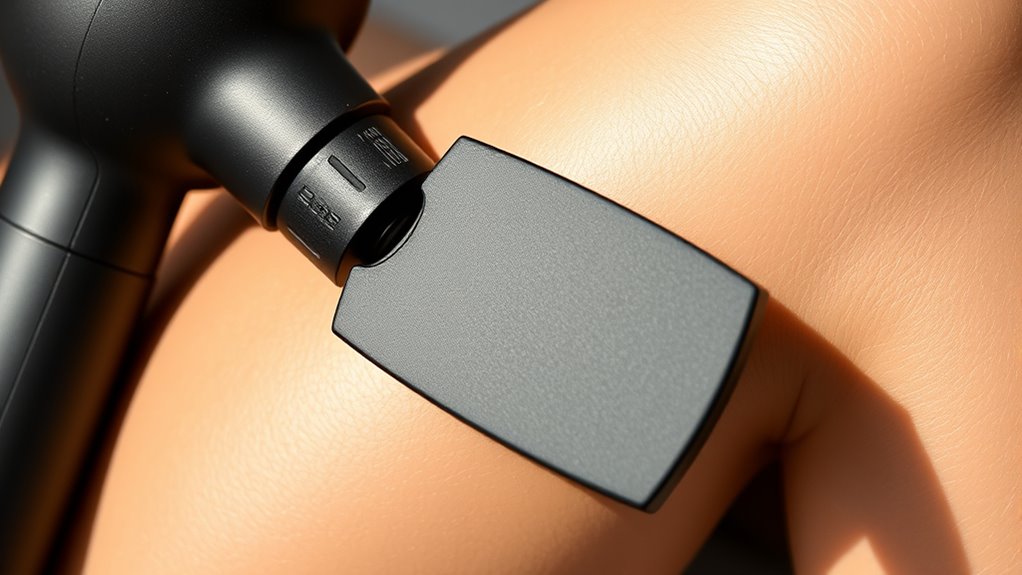
A flat attachment is designed to deliver broad, even coverage across larger muscle groups. Its ergonomic design guarantees comfortable handling and effective pressure distribution, making it ideal for muscle areas like the back, thighs, and shoulders. The flat shape helps you target wide surfaces without concentrating too much on one spot, reducing discomfort. When choosing your massage gun, check attachment compatibility to ensure a seamless fit with the flat attachment. This versatility allows you to switch easily between different attachments for customized relief. Use the flat attachment with steady, controlled motions to promote circulation and loosen tight muscles. Its ergonomic design and compatibility make it a practical choice for those looking to cover larger areas efficiently and comfortably. Supporting your well-being through regular use can help maintain muscle health and prevent injury.
Fork Attachment
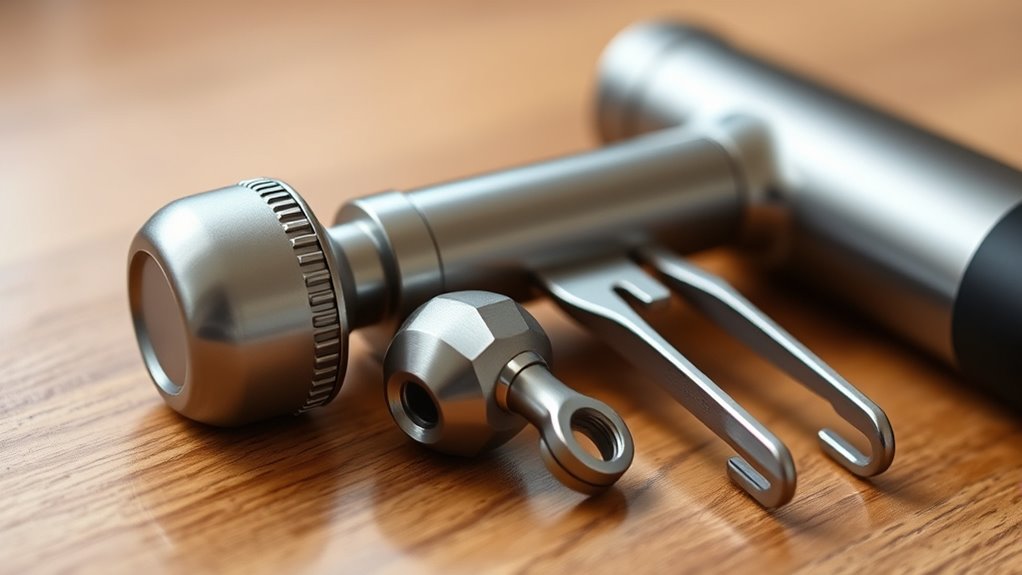
The fork attachment is great for targeting specific muscle groups like the neck and spine. It helps you reach tight spots more easily without putting strain on surrounding tissues. Using it can make your massage sessions more effective and comfortable. Additionally, proper attachment selection can enhance your overall massage effectiveness by focusing on problem areas precisely.
Different Muscle Groups Targeted
The fork attachment is specially designed to target specific muscle groups that are often hard to reach with larger heads. It’s ideal for working around bones and smaller muscles, supporting your recovery strategies and injury prevention. This attachment effectively targets areas like the neck, spine, and forearms, where precision matters. Using the fork attachment regularly can help you maintain muscle balance, prevent injuries, and accelerate recovery by addressing hard-to-reach spots that larger attachments might miss. It’s a versatile tool for detailed muscle work, especially when combined with proper massage technique to maximize effectiveness.
Ease of Access to Tight Spots
Replacing larger attachments with the fork attachment makes it easier to reach tight, hard-to-access spots. Its design allows you to target trigger points and areas where muscles converge, such as around the spine or between shoulder blades. The fork attachment excels at fascia release, helping to loosen tight fascia that restricts movement and causes discomfort. When you need precise pressure on small, stubborn knots, this attachment gives you better control. It’s especially effective for working around bony prominences and deep muscle tissues that larger attachments can’t access comfortably. By focusing on these hard-to-reach areas, you can relieve pain more efficiently and improve flexibility. The fork attachment is your go-to for tackling those persistent tight spots that often go unnoticed with bulkier options. Understanding regional resources and specialized tools can further enhance your massage therapy routine.
Cone Attachment

A cone attachment is designed to target specific muscles and trigger points with precision. Its narrow tip makes it ideal for pinpointing muscle knots and alleviating pain in tight areas. When using it, you can focus directly on areas that need extra attention. Here’s how to maximize its effectiveness:
- Identify trigger points or knots that cause discomfort.
- Gently apply pressure, moving slowly to break up muscle tension.
- Use short, controlled strokes to avoid overstimulation and promote relaxation.
- Incorporate targeted relief techniques for more effective muscle recovery.
This attachment is especially useful for small, hard-to-reach spots where larger attachments might not fit. It’s perfect for precise relief, helping you release tension and improve muscle mobility efficiently. Just remember to keep the pressure moderate and listen to your body’s responses.
Large Round Head

A large round head attachment offers broad, even coverage that’s ideal for large muscle groups like the back, thighs, and shoulders. It’s perfect for massage therapy sessions focused on relaxing muscles and reducing tension. The wide surface area allows you to deliver gentle, consistent pressure across a large area, making it easier to target stubborn knots or tightness. This attachment also promotes skin stimulation, encouraging blood flow and helping to loosen fascia. When using the large round head, you’ll find it effective for warming up muscles before deeper work or cooling down after activity. Its versatility makes it a go-to choice for overall muscle relaxation, ensuring you get the benefits of massage therapy with less effort and more comfort.
Small Round Head
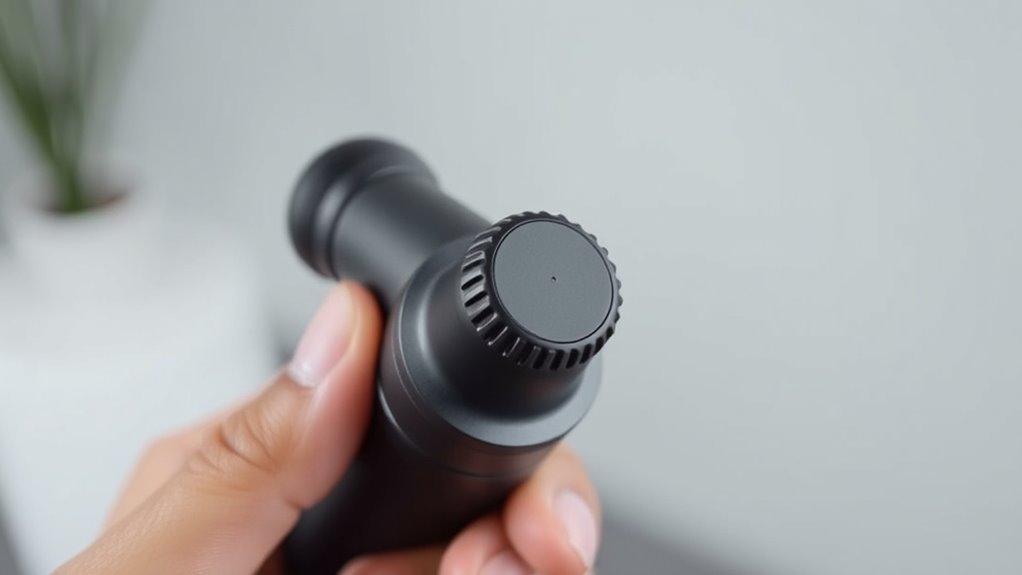
The small round head attachment is perfect for targeting precise, localized areas such as trigger points, joints, and smaller muscle groups. It allows you to focus your massage therapy efforts where it’s needed most, helping to reduce muscle tension and improve recovery. To maximize its benefits:
- Use light to moderate pressure for sensitive spots without causing discomfort.
- Focus on trigger points to release knots and alleviate pain.
- Incorporate slow, deliberate strokes to enhance muscle recovery and flexibility.
This attachment is ideal for fine-tuning your massage therapy routine, especially when working on specific muscles or joints. Its compact size helps you get into tight spots, making your muscle recovery sessions more effective and targeted.
Shovel Head
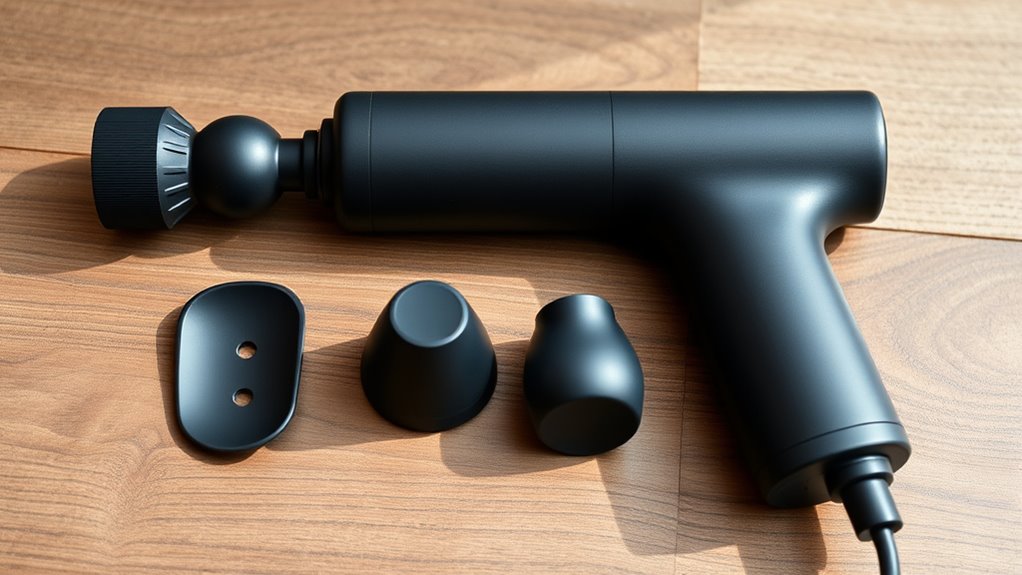
The shovel head is great for reaching deep into tense muscles, providing effective deep tissue penetration. It helps target specific areas that need quick relief without affecting surrounding tissues. If you’re after focused, intense muscle work, this attachment is a solid choice. Additionally, using this attachment can help prevent overuse injuries by allowing precise pressure application. Proper attachment use ensures optimal results and safety during your massage sessions.
Deep Tissue Penetration
When targeting deep muscle tissue, the shovel head attachment excels at delivering focused, intense pressure. It’s perfect for working on trigger points and fascia release, helping to break up knots and improve flexibility. To maximize effectiveness, consider these tips:
- Apply steady, deliberate pressure directly on tight spots or knots to stimulate trigger points.
- Use slow, controlled movements to penetrate fascia and release restriction.
- Focus on specific areas requiring deep tissue work, avoiding overly aggressive pressure that causes discomfort.
- The shovel head’s shape allows for precision, making it ideal for deep, targeted relief, especially when combined with knowledge of anatomy and muscle groups.
This attachment helps you reach the muscle’s core, promoting better blood flow and faster recovery without unnecessary surface irritation.
Targeted Muscle Relief
Looking to target specific muscles with precision? The shovel head attachment is your go-to for pinpointing trigger points and muscle knots. Its narrow tip allows you to focus on tight spots, delivering relief exactly where you need it. Imagine this:
| Muscle Area | Relief Method |
|---|---|
| Neck muscles | Loosen trigger points |
| Shoulder knots | Break down muscle knots |
| Forearm muscles | Ease tension in tendons |
| Lower back muscles | Target specific tight spots |
| Calf muscles | Relieve localized soreness |
With the shovel head, you can effectively loosen tight muscles without affecting surrounding tissue. Use it carefully on stubborn knots and trigger points to restore mobility and reduce pain, making your recovery targeted and efficient. Automation technologies are increasingly being integrated into health and wellness tools to enhance their effectiveness.
Wedge Attachment

Have you ever struggled to reach tight or awkward muscle areas with a standard massage gun head? The wedge attachment is perfect for targeting those tricky spots. Its flat, angled shape helps you maneuver around shoulder blades, neck muscles, and along the spine, making massage therapy more effective. For injury recovery, it allows precise pressure application without aggravating surrounding tissues. Use it in these ways:
The wedge attachment targets hard-to-reach muscles for more effective, precise massage therapy.
- Reach the upper back and shoulder blades for deep tissue relief.
- Target the sides of the neck to loosen tight muscles.
- Work along the spine without direct contact, protecting sensitive areas.
- It is also useful for targeting specific muscles in Kia vehicle tuning, such as suspension and engine modifications, to enhance overall performance.
This attachment enhances your ability to focus on specific muscles, making massage therapy more efficient and aiding faster injury recovery.
Thumb Attachment
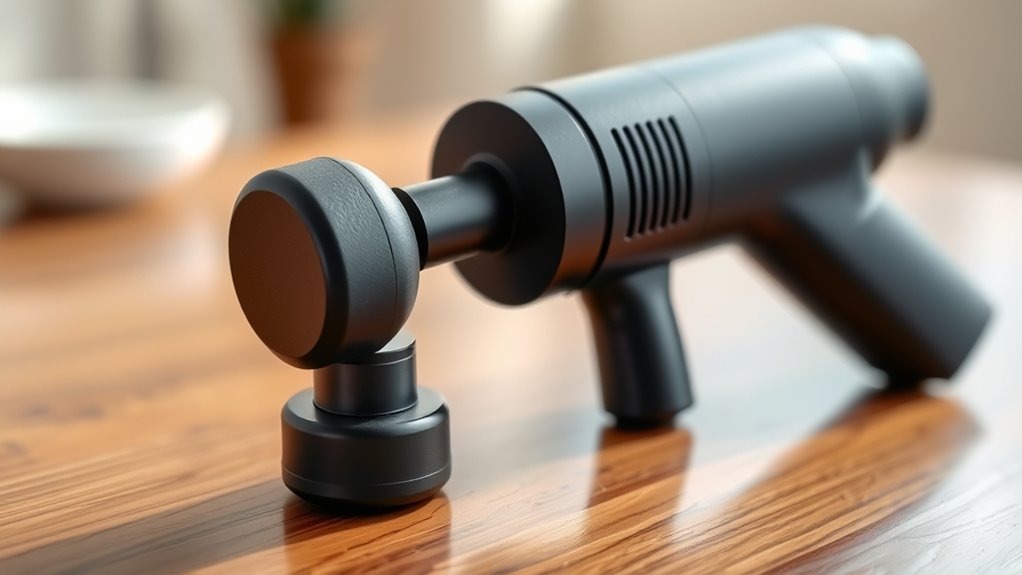
The thumb attachment mimics the shape and pressure of a human thumb, allowing you to apply targeted, deep massage to specific muscles. It’s especially useful for working on trigger points and tight spots, making it a valuable tool in massage therapy. With its precise design, you can focus on smaller areas or hard-to-reach spots, enhancing your massage routine. When selecting attachments, make certain of its compatibility with your massage gun to avoid any issues during use. The thumb attachment offers control and effectiveness, helping you relieve muscle tension and improve circulation. Whether you’re targeting your neck, shoulders, or back, this attachment provides a massage that feels natural and effective, making it a versatile addition to your collection of massage therapy tools. Proper attachment selection ensures optimal performance and comfort during your massage sessions.
Frequently Asked Questions
Can Attachments Be Used Interchangeably on Different Muscle Groups?
You might wonder if attachments can be used interchangeably on different muscle groups. While some attachments offer attachment compatibility across various muscle groups, it’s best to choose specific ones for targeted muscle group targeting. Using the right attachment enhances effectiveness and comfort, preventing injury. Always consider the attachment’s design and strength to make certain it suits the muscle area you’re working on, rather than assuming all attachments are interchangeable.
How Do I Clean and Maintain Massage Gun Attachments Properly?
To keep your massage gun attachments clean and maintain their longevity, you should follow simple cleaning routines after each use. Wipe the attachments with a damp cloth or alcohol wipe to remove sweat and debris. Avoid soaking them in water. Regular cleaning prevents bacteria buildup, ensuring safe use. Proper care extends the life of your attachments, so you get the most out of your investment and enjoy effective, hygienic massage sessions every time.
Are Certain Attachments Better for Specific Injury Recovery?
Certain attachments are better suited for specific injury recovery because of their attachment durability and versatility. For example, softer attachments like foam heads can help with gentle muscle relief, while harder ones like ball attachments target deeper tissue. You should choose attachments based on your injury type and recovery needs, ensuring they offer the right balance of durability and versatility for effective, safe treatment.
What Attachment Is Best for Deep Tissue Therapy?
For deep tissue therapy, you’ll want an attachment with high attachment versatility, like a conical or bullet shape. These attachments target deep muscle layers effectively. Remember, attachment safety is vital, so choose attachments designed for this purpose and use them at appropriate intensities. You’ll find that these attachments help break up knots and promote circulation, making them ideal for intense, focused deep tissue work.
How Often Should I Replace My Massage Gun Attachments?
You should replace your massage gun attachments based on their attachment lifespan and replacement frequency. Typically, it’s best to check them every few months or after extensive use, especially if you notice cracks, wear, or loss of effectiveness. Regular inspection helps prevent potential damage or hygiene issues. Generally, replacing attachments every 6 to 12 months is recommended to ensure peak performance and safety during your massage sessions.
Conclusion
Knowing the right massage gun attachments can boost your recovery and soothe sore muscles effectively. Did you know that using the correct attachment can reduce muscle soreness by up to 50%? With options like the ball, bullet, and fork attachments, you can target specific areas for personalized relief. Experiment with these tools to find what works best for you, and turn your massage session into a quick, powerful way to feel better every day.
